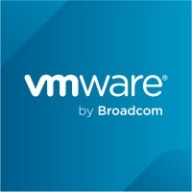
![Citrix SD-WAN [EOL] Logo](https://images.peerspot.com/image/upload/c_scale,dpr_3.0,f_auto,q_100,w_64/r353lx2ff1iz086wtljecg7wmrvo.jpg)

VMware VeloCloud SD-WAN and Citrix SD-WAN are competitors in the software-defined wide area network (SD-WAN) category. VMware VeloCloud appears to have an upper hand due to its advanced cloud integrations, ease of use, and strong Dynamic Multipath Optimization.
Features: VMware VeloCloud SD-WAN is notable for Dynamic Multipath Optimization, which enhances link management and application prioritization for better network performance. It also offers simple deployment and robust centralized control, coupled with cloud web security features. Citrix SD-WAN stands out for its connectivity capabilities between branches, load balancing, and a high degree of customization. It is appreciated for flexibility in managing bandwidth and communications and features like HDX WAN Optimization.
Room for Improvement: Citrix SD-WAN may improve with enhanced lifecycle communication, more intuitive configuration options, and better security features. Users also suggest better reporting capabilities and more competitive pricing. VMware VeloCloud SD-WAN could benefit from integrated security improvements, better SASE capabilities, and pricing adjustments. Enhancements in setup simplicity and cloud integration functionalities are also desired by users.
Ease of Deployment and Customer Service: Citrix SD-WAN is primarily on-premises, with varying customer service experiences, though local resellers enhance user interactions. VMware VeloCloud offers greater deployment flexibility across cloud environments, with generally positive customer service feedback, despite occasional struggles with support intricacies.
Pricing and ROI: Citrix SD-WAN is perceived as expensive, but its perpetual license aids in cost management. Its annual subscription is competitively priced next to some peers, enhancing ROI, particularly saving on telecom costs. VMware VeloCloud SD-WAN is also costly but offers value with competitive pricing aligned with features and cloud usage. Its flexible pricing models cater to varied usage scenarios and provide significant ROI potential.



| Company Size | Count |
|---|---|
| Small Business | 350 |
| Midsize Enterprise | 130 |
| Large Enterprise | 187 |
| Company Size | Count |
|---|---|
| Small Business | 7 |
| Midsize Enterprise | 5 |
| Large Enterprise | 10 |
| Company Size | Count |
|---|---|
| Small Business | 22 |
| Midsize Enterprise | 14 |
| Large Enterprise | 20 |
Fortinet FortiGate excels in providing integrated VPN, firewalling, and Unified Threat Management (UTM) with centralized management and high availability. It supports remote access and comprehensive threat protection, making it a preferred choice for securing networks.
Fortinet FortiGate offers a robust security platform with features such as strong intrusion prevention, application control, and web filtering. Its integration with Active Directory and SD-WAN functionality provides scalable solutions for large networks. Users appreciate its ease of use through centralized management interfaces, ensuring robust security with flexible configurations. However, FortiGate could enhance its graphical interface and technical support responsiveness, address firmware bugs and costly licensing, improve logging, integrate better with third-party tools, and strengthen scalability and memory for log storage. Complexity in configuration and the need for intuitive features are noted challenges, and there's a demand for advanced security, zero-trust capabilities, and AI integration.
What are the key features of Fortinet FortiGate?Fortinet FortiGate is widely implemented across industries like education, finance, and government. Companies use it for firewall protection, VPN, and SD-WAN capabilities, ensuring secure perimeter and data center security. It facilitates remote access management and traffic routing optimization, offering reliable security and connectivity solutions.
Citrix SD-WAN [EOL] enhances connectivity and performance by optimizing bandwidth utilization, ensuring reliable communication across branch offices and headquarter data centers. It offers centralized management, efficient deployment options, and improved network reliability.
Citrix SD-WAN [EOL] is designed for businesses seeking enhanced connectivity solutions that boost application performance while reducing costs. With HDX WAN Optimization and reliable Active-Active connectivity, it assures improved bandwidth management. Tailored for both cloud and on-premise deployments, it supports fast communication and seamless integration, making it user-friendly even for those with limited technical expertise. Security features and zero-touch deployments further enhance its appeal. However, users highlight areas needing improvement, such as configuration intuitiveness, pricing alignment for specific markets, and stability. Enhanced reporting, networking features, and technical support are desired. Integration with Windows, security elements like firewalls, and licensing clarity require attention to meet user expectations.
What are the key features of Citrix SD-WAN [EOL]?Industries benefit from Citrix SD-WAN [EOL] by leveraging its features to ensure stable, redundant connectivity between branches and data centers. Organizations experiencing frequent line failures or high reliance on bandwidth-heavy applications find it particularly useful. It caters to sectors needing reliable data management and enhanced networking.
VMware Software-Defined Wide Area Network (SD-WAN) is a secure access service edge (SASE) platform that combines many types of software-based network technologies in an attempt to enable users to virtualize their wide area networks and reduce their reliance on hardware. In essence, this solution makes it possible for users to reliably access their applications from anywhere in the world by leveraging cloud technologies. Users can simply, efficiently, and completely control their network devices and traffic. It ensures that organizations are always able to use the best possible connection to their data centers. VMware SD-WAN steers traffic so that it is always using the most reliable connections and at the same time takes steps to remediate any problems that it detects in other network links. This guarantees that organizations can access high-priority applications at all times.
VMware SD-WAN Benefits
Some of the ways that organizations can benefit by deploying VMware SD-WAN include:
VMware SD-WAN Features
Reviews from Real Users
VMware SD-WAN is a solution that stands out when compared to many of its competitors. Two major advantages it offers are its ability to automate the process of creating and maintaining a virtual local area network and its intuitive user dashboard.
Sami I., principal cloud architect at Loihe, writes, “One of the solution's most valuable features is the VMware core automation stack at an SDDC. It includes NSX, the VMware virtualization layer for the networks (the LAN virtualization), which works extremely well with the VMware SD-WAN solution and is the primary advantage over all the others. None of the other vendors could integrate with the virtual LAN, making it quite complicated and virtualized to be fully automated.”
Chih S., senior technical consultant at a tech services company, says, “The product has a very good user dashboard that is simple to navigate.”
We monitor all Software Defined WAN (SD-WAN) Solutions reviews to prevent fraudulent reviews and keep review quality high. We do not post reviews by company employees or direct competitors. We validate each review for authenticity via cross-reference with LinkedIn, and personal follow-up with the reviewer when necessary.